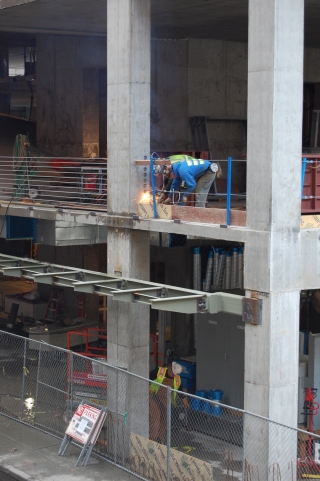|
Subscribe / Renew |
|
|
Contact Us |
|
| ► Subscribe to our Free Weekly Newsletter | |
| home | Welcome, sign in or click here to subscribe. | login |
Construction
| |

April 11, 2013
Construction experts: Prepare for skilled worker shortage next year
Special to the Journal
Like much of the rest of the country, the Puget Sound area is seeing a slow but steady comeback in the construction industry. Employment numbers comparing 2013 with 2012 show a trend in the right direction after years of double-digit unemployment.
But the new worry among contractors is not gloomy forecasts for construction spending. Rather, they are concerned whether there will be enough workers to meet the coming demand.
Statistics released this week by the Associated General Contractors of America show that construction employment increased in more than half of U.S. metropolitan areas between February 2012 and February 2013. The Seattle/Bellevue/Everett area saw a 5 percent increase in jobs in the same time frame.
Ken Simonson, AGC of America's chief economist, said there is a looming shortage of certain types of construction workers just as the industry is beginning to recover.
For Washington, the worker shortage hovers on the horizon. “Everyone I've talked to is aware that a workforce shortage is looming,” said Jerry VanderWood, director of communications for the AGC of Washington. “They are worried that, in a year from now when things pick up, it will be tough. They're anxious about the longer term.”
The employee availability “pinch,” as VanderWood calls it, will be caused by a combination of factors. The recession, he said, contributed to a dip in applicants for construction degrees at the college level. In addition, he said high schools are offering fewer courses in technical areas to prepare students for work in the construction trades.
“The issue is that we have perhaps underplayed the value of a technical education in high schools,” VanderWood said. “We don't see as many shop classes anymore.”
To add more pressure on the possibility of a worker shortage, VanderWood said some workers who left construction when the recession hit in 2008 and 2009 simply decided not to come back to the field.
“The demographics have been working against us,” he said. “There is a certain amount of people who have left the industry, have retired, or gone on to find gainful employment and will not come back even when the opportunity presents itself.”
Joe Simmons of Joseph S. Simmons Construction in Seattle said construction workers who left or were laid off in the recession may have sought jobs at companies such as Boeing and simply decided that it's easier to stay than come back to the less stable construction industry.
“That's the problem we're having and we're still not attracting workers back to the industry the way we should,” said Simmons. “This worker shortage will be more acute. It's going to be worse than 2006.”
Simmons said training would-be trades people at an early age has not kept up with demand. “Where we are really falling down is craft training,” he said. “It's barely taught in high schools.”
In general, he said, the trend in Washington is “the higher you go up the skill level, the fewer workers there are. If you're looking for a superintendent, it's pretty hard now.”
Simmons said “we're at an equilibrium now” in which there are just enough well-trained workers to fill positions, but the equilibrium will shift in the next year toward a worker shortage.
Finding entry-level workers is not a problem at the moment, Simmons said. Simmons Construction, for example, recently posted an ad on Craigslist for a truck driver, and the company was inundated with hundreds of responses for the $18-an-hour position.
“We ended up with an unbelievably qualified truck driver with a college degree who was looking to break into the construction industry,” he said.
According to Simmons, it's an employers' market for entry-level jobs, but much more challenging for skilled jobs.
As the shortage of workers becomes more acute, Simmons predicted wage inflation at many levels of the construction industry workforce.
AGC of America CEO Stephen Sandherr said Tuesday that there has been a “dismantling of skills-based vocational training” in the U.S., which will hurt the size of the labor pool in years to come.
VanderWood said the AGC of Washington is doing its part to spur interest at early levels for construction jobs, as well as help seasoned workers increase their skills set. He pointed to the local AGC Education Foundation as a program serving everyone from grade school students through construction industry employees with classroom training as well as field training.
“Construction is not always perceived as an enticing career for a lot of kids,” he said. “We need to let them know it is a satisfying career with well-paid jobs.”
Simmons predicted that as construction continues to pick up steam in 2013 and 2014, companies will have to compete for skilled workers.
“As construction firms get busy, they will all be fighting for the same people,” he said. “It's going to be unpleasant.”
Still, given the severity of the recent recession, Simmons said he's happy the trend in workload is improving.
“I prefer the way things are now,” he said.
Previous columns:
- Got potholes? Soon there'll be an app for that, 04-04-2013
- Builders scramble to find land as market rebounds, 03-28-2013
- Accordion-like truss system plays a big role at Capitol Hill transit station, 03-21-2013
- Some lawyers embrace ‘plain English' initiative, 03-14-2013
- U District project will be the first test of a new way to build, 03-07-2013
- WSDOT tries its luck with wireless puck, 02-28-2013
- Equipment thieves thwarted by GPS system, 02-21-2013
- MOHAI’s ‘Wawona': 11,000 pounds of wood and steel moves with a gentle push, 02-14-2013



